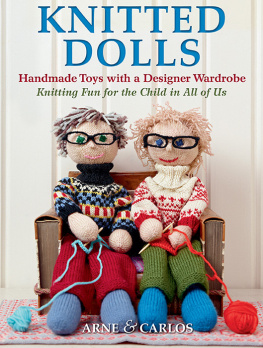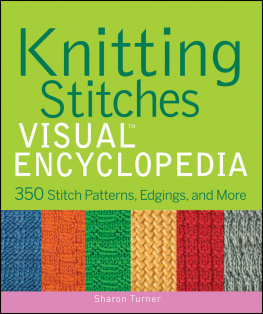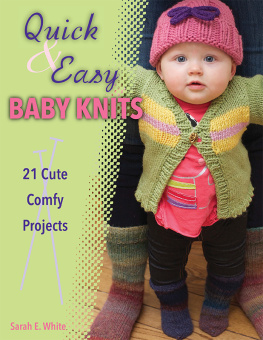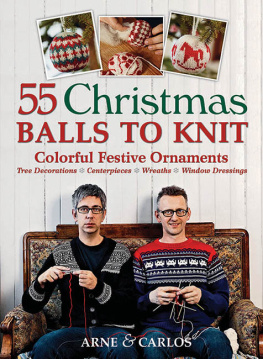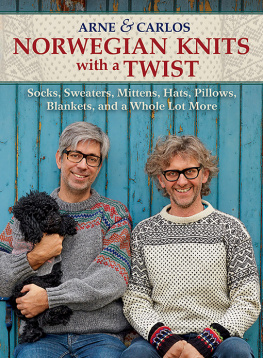ARNE & CARLOS
Norwegian Knits with a Twist
First published in the United States of America in 2014 by
Trafalgar Square Books
North Pomfret, Vermont 05053
Originally published in Norwegian as Strikk fra Setesdal.
Copyright 2013 Cappelen Damm AS
English translation 2014 Trafalgar Square Books
All rights reserved. No part of this book may be reproduced, by any means, without written permission of the publisher, except by a reviewer quoting brief excerpts for a review in a magazine, newspaper or web site.
ISBN: 978-1-57076-698-5
Library of Congress Control Number: 2014936077
The instructions and material lists in this book were carefully reviewed by the author and editor; however, accuracy cannot be guaranteed. The author and publisher cannot be held liable for errors.
Translation by Carol Huebscher Rhoades
Photography: Ragnar Hartvig
Stylist: Ingrid Skansaar
Models: Ulrikke de Vibe
Book design: Hanne Marie Kjus
Illustrations: Arne & Carlos
Printed in China
10 9 8 7 6 5 4 3 2 1
CONTENTS
PREFACE
Arnes grandmother was from Setesdal. Her name was Torbjrg Heistad and she was born in the parish of Austad in Bygland on July 7, 1895. It was a long way to Srlandet when Arne was a child and even further up to Setesdal. It wasnt until he was an adult that he made it to Byglandsfjord and found a ramshackle house behind the birches and underbrush. A house where children had played and painted on the walls and where wood antsand plenty of themwere now the only inhabitants.
In the attic, the floor was covered with old magazines, letters, and Christmas cards. On top of all the rubbish lay a picture of Arnes mother when she was young, a picture she had certainly sent to her grandmother. He took the picture with him when he left.
Many years later, we met Annemor Sundb outside the Opera House in Oslo. We had arranged to meet there to talk about knitting, and she told us that she had also been in the same attic where she found a Christmas card that she reproduced in her book, Knitting in Art.
This book is based on the textiles, patterns, and books from our collection. Much of the inspiration came from the attic of the old house, in pictures we found in old books and on postcards, and in old knitting patterns and books.
An attic is not only the highest room in a house but also the houses second floor. In the old days, it was common to use the first floor as the living space and the attic as dressing rooms and bedrooms. The house was like a two-story storehouse:
He brought in carpenters from Holland to build the attic. It was well made overall. The lumber was finely hewn, planed, and finished. It was covered with green fabric; vadmal (fulled woven fabric) was most common. One wall up in the attic was covered with pictures from foreign countries.
Finally, we should also say a few words about how we work: We wholeheartedly believe that one should anchor new designs in the old traditions. That is what happens when we go back in time and examine our cultural heritage and historywe can bring something back to incorporate into our work and create something new. At the same time as we create something new, we are also contributing back to the old traditions.
The 33 patterns in this book have been inspired by Setesdals cultural heritage and patternsbut they were designed with our own twist. We hope everyone will be as inspired by Norwegian Knits with a Twist as we have been. We wish you all good knitting!
CHAPTER 1
LICE SWEATERS
Lice sweaters (lusekofta) from Setesdal have a long tradition in Norway and have been knitted in Setesdal since the middle of the nineteenth century. The patterns on the Setesdal sweaters are the most recognizable in the Norwegian knitting tradition and have come to symbolize the authentic Norwegian elsewhere in the world.
They had begun to wear the easterners clothing in Setesdal, and they put on so much silver that the garments became terribly heavy. But the teachers kept to the old ways: Olav Halvorsson and Bjug kre sold all their silver and vowed never to adorn children with silver. Tor Bjrguvsson and Olav were the last men to wear loose sweaters and short pants in Valle.
The Norwegian version was loosely translated from Johannes Skar,
Gamalt or Setesdal [Old Ways in Setesdal]

SETESDAL
SWEATERS
There are some old motifs that are always included on Setesdal sweaters and which give them their characteristic look.
A lusekofte or lice sweater should have the cross and ring [kross (or kors) og kringle] pattern, and this is the value mark of the sweater. The cross is named for Andrew, one of Jesus disciples. He was condemned to death by being fastened to a cross but chose a cross in the form of an X because he believed that he was not worthy of dying in the same manner as Jesus. The ring symbolizes lifes wheel, the sun symbolthe eternal, life-giving source of energy.
The next motif which is found on Setesdal sweaters is the zigzag border that is often called a hook border. This border is older than the cross and ring patterns. The zigzag symbolizes cleansing water, lifes water, or the gospel.
The lice (evenly distributed individual white stitches on a black background) are also characteristic of these sweaters. They decorate the sweater while also making it warmer. Traditionally, the sweater was always knitted with black, which was considered the finest color, while the lice and all the other patterns were knitted in white.
In addition, the sweaters were decorated with embroidery, lyesaum. Today there are very few people who know the art of this embroidery since the patterns were never drawn by hand but were sewn free-hand. While it was always possible to improvise and make choices regarding color and decorative experiments as the embroiderer worked, the embroidery was also determined by very strict forms and rules. Sometimes the sweater might be edged with green felt fabric.
The lower part of a Setesdal sweater was always white. White wool was the cheapest and the sweater would always be tucked down into the high trousers worn by men so the lower edge was never visible and no one knew it was knit with a cheaper color. Many of the older people in the area thought it was unseemly to show the white section of a sweater since it was regarded as underclothing. When the knitted sweater came to Setesdal, they had already begun yarn dyeing. Before that time, they only wore a short vadmal (heavily fulled woven fabric) garment with a small amount of embroidery.


